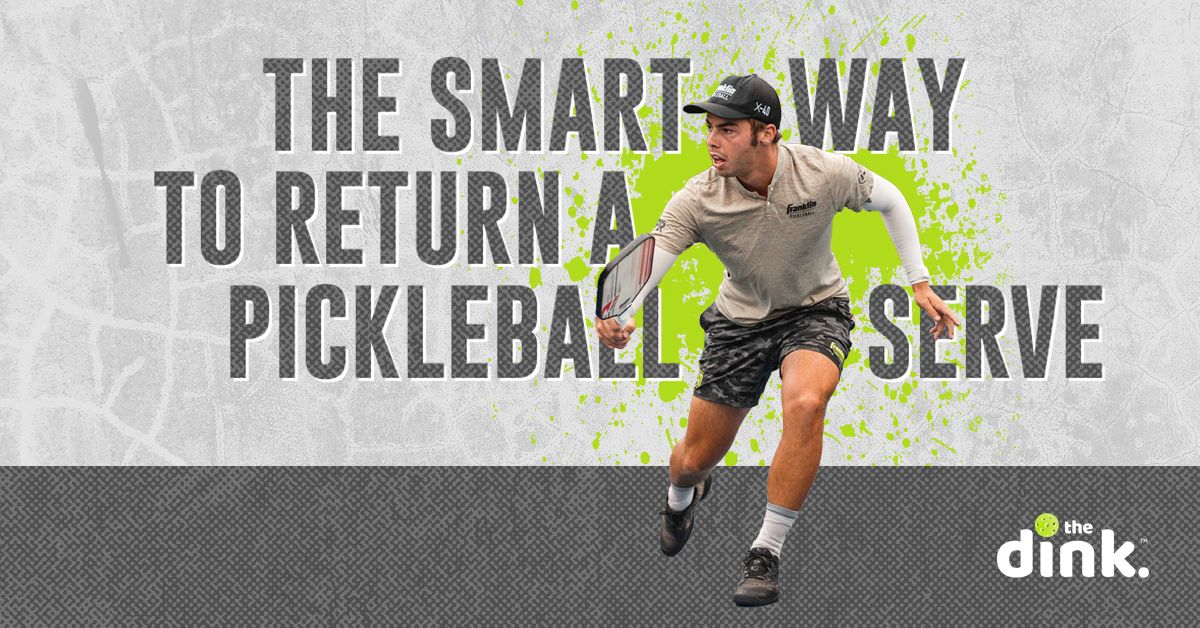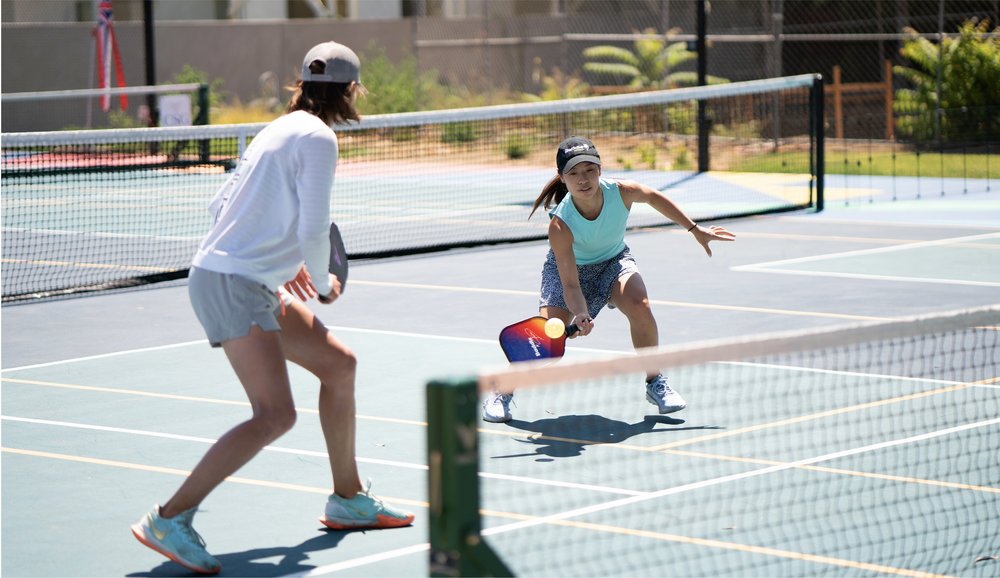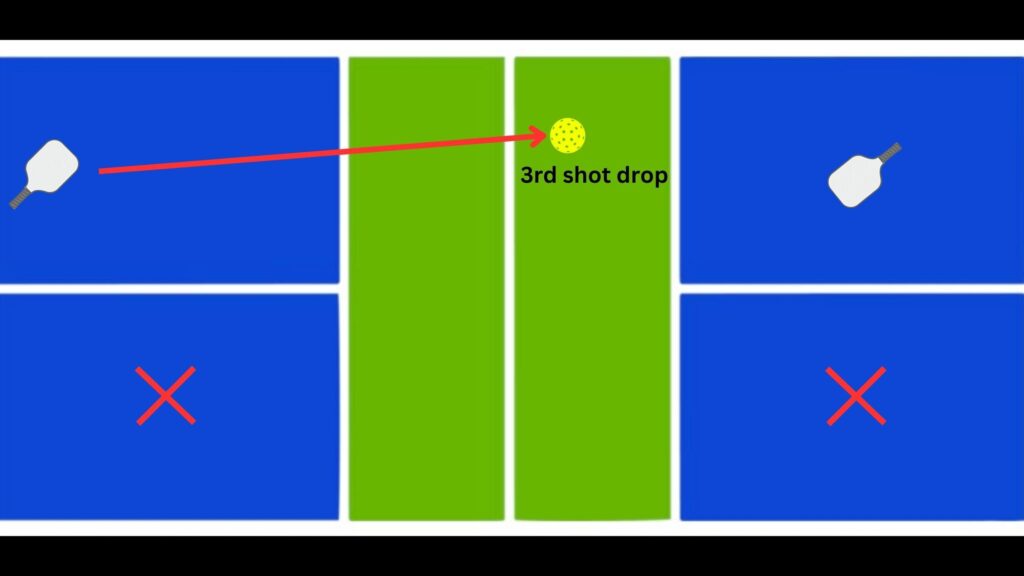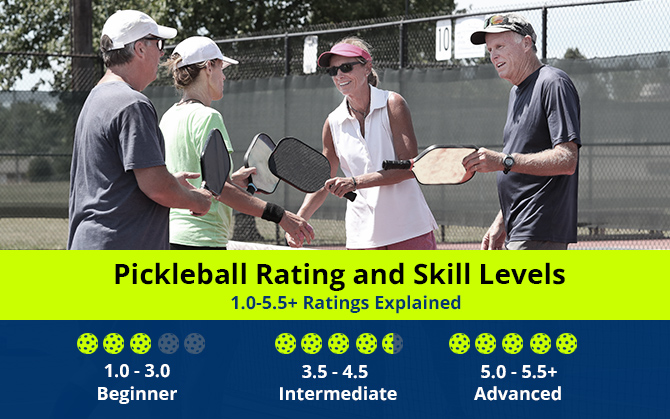Return serve in pickleball by following these steps: position yourself near the centerline, anticipate the direction of the serve, move quickly to reach the ball, and aim for a deep return towards the opponent’s baseline. In pickleball, returning serve is a crucial skill that requires anticipation, agility, and accuracy.
By positioning yourself strategically, reading your opponent’s body language, and reacting swiftly, you can effectively return the serve. This article will provide tips and techniques on how to return serve in pickleball, allowing you to gain an advantage in the game and keep your opponent on their toes.
So, let’s dive in and explore the key aspects of returning serve in pickleball.

Credit: theartofpickleball.net
The Importance Of The Return Serve
If you want to master the game of pickleball, one skill that you absolutely cannot overlook is the return serve. The return serve refers to the player’s ability to counteract their opponent’s serve and send the ball back over the net. Many players tend to focus solely on their serving skills, but underestimating the importance of a strong return serve can be a fatal mistake.
Why The Return Serve Is Crucial In Pickleball?
The return serve carries immense significance in the game of pickleball. It is the shot that initiates the rally and sets the tone for the rest of the game. The return serve is your opportunity to take control, seize momentum, and put your opponent on their back foot. A solid return serve not only puts pressure on your opponent but also allows you to dictate the pace and direction of the rally.
How The Return Serve Sets The Tone For The Rest Of The Game
By delivering a powerful and well-placed return serve, you can immediately establish your presence on the court and showcase your skills. This psychological advantage can have a profound impact on your opponent, causing them to feel pressured and potentially making mistakes. Furthermore, a strong return serve can demoralize your opponent and shake their confidence, giving you an edge throughout the match.
It is crucial to understand that the return serve is not just a defensive shot but also an offensive opportunity. By returning the serve effectively, you can aim to neutralize your opponent’s advantage and potentially gain an upper hand in the rally. This ability to turn defense into offense is what separates great players from good players in pickleball.
In conclusion, mastering the art of the return serve in pickleball is an essential skill to develop if you want to excel in the game. It not only allows you to initiate the rally, but it also sets the tone for the rest of the match, giving you a psychological advantage over your opponent. Practice your return serve diligently, focusing on precision, power, and placement, and watch as your game reaches new heights!

Credit: www.thedinkpickleball.com
Mastering The Basic Techniques
Returning serve in pickleball is a crucial skill that can make or break your game. To effectively return serve, you need to master the basic techniques, including the proper grip and body positioning. In this step-by-step guide, we will walk you through the fundamentals of returning serve, ensuring you are equipped with the knowledge to excel on the court.
Grip And Body Positioning For An Effective Return
An essential aspect of returning serve in pickleball is having the right grip and body positioning. By adopting the correct grip, you can ensure maximum control and power over the ball, while proper body positioning will lay the foundation for a successful return. Let’s dive into each of these aspects in more detail:
Grip
To achieve an effective return, start by gripping the paddle correctly. This starts with a relaxed grip, allowing for flexibility and maneuverability. Place your non-dominant hand on the bottom of the paddle’s handle, with your fingers comfortably wrapped around it. Your dominant hand should be placed higher up the handle, creating a secure and stable grip. Remember, your grip should feel natural and comfortable, allowing for smooth movement and control.
Body Positioning
Proper body positioning is key to executing a solid return serve. Start by positioning yourself in the “ready” stance – feet shoulder-width apart, knees slightly bent, and weight evenly distributed. This posture will provide a stable base for quick movements and efficient stroke execution. Keep your body facing the net, ensuring you have a clear view of the incoming serve. As the server prepares to strike, shift your weight to your back foot, ready to explode forward and meet the ball with decisive accuracy.
7 Steps To Executing A Basic Return Serve
Now that you understand the importance of grip and body positioning, let’s walk through a step-by-step guide to executing a basic return serve:
- Position yourself in the ready stance, feet shoulder-width apart, and knees slightly bent.
- Hold the paddle with a relaxed grip, your non-dominant hand on the bottom and your dominant hand higher up the handle.
- Keep your eyes on the server, anticipating the direction of the serve.
- Just before the serve, shift your weight to your back foot.
- As the ball is released by the server, explosively step forward with your front foot and rotate your hips and shoulders towards the net.
- Contact the ball at the center of the paddle, using a controlled and compact swing.
- Ensure your follow-through is smooth, extending the paddle towards the target.
By following these steps and incorporating the correct grip and body positioning, you will be well on your way to mastering the art of returning serve in pickleball. Practice regularly and refine your technique to become a formidable opponent on the court.
Strategies For A Successful Return
Returning serves in pickleball is a crucial skill that can give you the upper hand in a game. To improve your return game, it’s important to develop effective strategies that capitalize on your opponent’s weaknesses and make use of placement, speed, and shot selection. In this article, we’ll explore three key strategies that can help you master the art of returning serves in pickleball.
Identifying Your Opponent’s Weaknesses
One of the first things you should do when returning a serve is to identify your opponent’s weaknesses. By keenly observing their playing style, you can gather valuable insights that can be used to your advantage. Look out for areas where their shots tend to fall short or their footwork seems weak. This could be their inability to handle fast-paced shots, struggle with volleys, or difficulty returning serves to a specific part of the court. Once you identify their weaknesses, you can tailor your return shots accordingly, putting them in a tight spot and increasing your chances of scoring a point.
Using Placement And Speed To Your Advantage
Placement and speed are two critical factors that can greatly impact the success of your return serve in pickleball. By strategically placing your shots, you can force your opponent into awkward positions, making it harder for them to respond effectively. Aim to hit the ball to areas of the court that are farthest away from your opponent or where they aren’t expecting it, such as the corners. Additionally, varying the speed of your shots can catch your opponent off guard. Mixing up slower shots with faster ones can disrupt their rhythm and make it harder for them to anticipate your returns.
Effective Shot Selection For Different Serves
Another key strategy for a successful return is utilizing effective shot selection based on the type of serve you are facing. Different serves require different approaches, and choosing the right shot can give you a competitive advantage. For example, when facing a low serve, you may want to use a low forehand return to keep the ball low and force your opponent into a difficult position. On the other hand, when facing a high serve, you might opt for a deep backhand return to prevent your opponent from attacking the net and gaining control of the point. Adapting your shot selection to match the serve can help you neutralize your opponent’s advantage and set yourself up for a strong return.
In conclusion, developing effective strategies for returning serves in pickleball is key to gaining an edge over your opponent. By identifying their weaknesses, using placement and speed to your advantage, and selecting the appropriate shots for different serves, you can elevate your return game and improve your overall performance on the court.
Dealing With Powerful Serves
Learn how to effectively return serves in pickleball, even when facing powerful shots. Discover strategies and techniques to improve your game and stay competitive on the court.
Adapting Your Return To Handle Fast And Powerful Serves
When facing opponents with fast and powerful serves in pickleball, it’s important to adjust your return strategy to handle these challenging shots effectively.
Defensive Techniques For Returning Power Shots
Returning power shots requires a combination of defensive skills and techniques to ensure a successful return. Here are some strategies to help you handle those powerful serves and keep the game in your favor:
1. Stay on your toes: Be ready to react quickly by staying on your toes and maintaining a balanced stance. This will allow you to move swiftly and get into a good position for an effective return.
2. Watch the server’s paddle: Pay close attention to the server’s paddle as they make contact with the ball. By focusing on their paddle, you can anticipate the velocity and direction of the serve, enabling you to react faster.
3. Position yourself strategically: Position yourself a few steps back from the baseline to give yourself ample time to react to the powerful serve. Find a comfortable distance that allows you to react without feeling rushed.
4. Use a shorter backswing: When returning a power shot, use a shorter backswing to maintain better control and accuracy. By minimizing the backswing, you can increase the speed of your return and keep the ball low and close to the net.
5. Block rather than swing: Instead of taking a full swing at the ball, consider using a blocking technique. This involves a small, controlled movement that redirects the power of the serve back over the net. Focus on timing and precision to execute this technique effectively.
6. Stay calm and composed: It’s natural to feel rushed when faced with a powerful serve, but it’s crucial to remain calm and composed. Keep your focus on the ball and trust your reflexes. A calm mindset will help you make better decisions and execute your returns more effectively.
Remember, practice makes perfect. The more you face powerful serves and practice returning them, the better you’ll become at adapting to these challenging shots. With time and dedication, you’ll develop the defensive skills needed to handle powerful serves and gain an advantage on the pickleball court.
Returning Different Types Of Serves
Returning serves in pickleball requires quick reflexes and adaptability. Knowing how to return different types of serves can give you a competitive edge on the court. In this section, we will discuss techniques for returning spin serves, adapting your return for slice serves, and handling high bounce serves.
Tips For Returning Spin Serves
Spin serves can pose a challenge if you’re not prepared. Here are a few tips to help you return spin serves like a pro:
- Anticipate the spin: Watch your opponent’s paddle and body position to determine the type and direction of spin on the ball.
- Use a shorter backswing: To counteract the spin, shorten your backswing and focus on making contact with the ball in the center of your paddle.
- Adjust your grip: Experiment with different grips, such as the Eastern or Continental grip, to find the one that gives you better control over the spin.
- Angle your paddle: By angling your paddle slightly, you can redirect the spin and send the ball back to your opponent with added difficulty.
Adapting Your Return For Slice Serves
Slice serves in pickleball are typically hit with sidespin, causing the ball to curve in one direction. Here’s how you can adapt your return to effectively handle slice serves:
- Watch the ball closely: As the ball leaves your opponent’s paddle, focus on its trajectory to anticipate the curve.
- Adjust your positioning: Position yourself slightly to the opposite side of the anticipated curve, allowing you to meet the ball at the right angle.
- Use a shorter backswing: Similar to returning spin serves, opt for a shorter backswing to maintain control and accuracy.
- Work on your footwork: Quick lateral movements can help you cover more ground and get into an optimal position for returning slice serves.
Handling High Bounce Serves
High bounce serves can catch you off guard if you’re not prepared. Here are a few techniques to help you handle high bounce serves effectively:
- Stay on your toes: Be ready to move quickly as soon as you see the high bounce serve coming your way.
- Step back: Take a step or two back to give yourself more time to react to the high bounce.
- Keep your eye on the ball: Focus on the ball’s trajectory and make contact when the ball is at a comfortable height for you.
- Use your legs: Bend your knees and use your legs to help you generate power and control when returning a high bounce serve.
Drills And Exercises To Improve Your Return Serve
Returning a serve in pickleball can be a challenging task, requiring precision, control, agility, and quick reaction time. To enhance your return serve skills, incorporating drills and exercises into your practice routine can make a significant difference. The following section outlines a variety of solo practice drills, partner drills, and fitness exercises that can help improve your return serve in pickleball.
Solo Practice Drills For Precision And Control
Practicing your return serve solo allows you to focus on developing precision and control without the pressure of a game situation. Here are a few drills to incorporate into your solo practice sessions:
- Target Practice: Set up targets on the opposite side of the court and aim to consistently hit them with your return serve. Gradually increase the difficulty by decreasing the size of the targets.
- Line Drills: Stand on one baseline and practice returning serves that land close to the sideline. This drill helps improve your accuracy and ability to return serves that hug the lines.
- Rhythm Training: Practice returning serves with a consistent rhythm, focusing on timing and fluid motion. This drill helps develop a smooth and controlled return.
Partner Drills To Simulate Game-like Situations
Working with a partner allows you to simulate game-like situations and challenge your return serve skills under varying conditions. Here are a few partner drills to try:
- Random Placement: Have your partner serve to different areas of the court, forcing you to quickly react and return the ball with accuracy. This drill helps improve your agility and decision-making skills.
- Speed and Power: Ask your partner to increase the speed and power of their serves, challenging your ability to make a quick and controlled return. This drill helps improve your reflexes and ability to handle fast serves.
- Moving Target: Have your partner move side to side or forward and backward while serving, requiring you to adjust your footwork and timing. This drill helps replicate the movement of opponents during a game.
Fitness Exercises To Enhance Agility And Reaction Time
Being physically fit and agile is essential for a solid return serve. Incorporating specific fitness exercises into your training routine can help enhance your agility and reaction time. Here are a few exercises to consider:
- Agility Ladder Drills: Set up an agility ladder and perform various footwork exercises, such as lateral movements and quick steps. This drill improves your agility and coordination, key components of an effective return serve.
- Reaction Ball Exercises: Throw or bounce a reaction ball against the wall and react quickly to catch it or hit it back. This drill enhances your reaction time and hand-eye coordination, crucial for a successful return serve.
- Interval Training: Incorporate high-intensity interval training (HIIT) into your fitness routine, combining short bursts of intense exercise with periods of rest. This type of training improves your overall fitness level, endurance, and speed.

Credit: m.youtube.com
Frequently Asked Questions
What Are The Rules For Return Of Serve In Pickleball?
Return of serve in pickleball follows certain rules. The server must stand behind the baseline, send the ball diagonally across the net, and make sure it lands in the opponent’s diagonally opposite service box. The returner must let the ball bounce before hitting it, and the serve must be returned to the server’s court without hitting the net or going out of bounds.
How Do You Serve And Return Like A Pro In Pickleball?
To serve and return like a pro in pickleball, focus on these tips:
1. Practice your serve and return techniques consistently.
2. Aim for accuracy and placement rather than just power.
3. Keep your body balanced and use proper footwork.
4. Observe your opponent’s positioning and adjust accordingly.
5. Focus on staying relaxed and maintaining good form throughout the game.
Can You Return The Serve Without A Bounce In Pickleball?
Yes, in pickleball, you must let the serve bounce before returning it.
Where Is The Best Place To Return A Serve In Pickleball?
The best place to return a serve in pickleball is deep to the server’s backhand. By hitting it deep, you give yourself time to get in position and put pressure on your opponent. Aim for the middle of the court to make it harder for them to attack.
Conclusion
Mastering the art of returning serves in pickleball is crucial for any player looking to level up their game. By following the techniques and strategies discussed in this blog post, you are well-equipped to confidently handle any serve that comes your way.
Remember to focus on your positioning, footwork, and timing, as well as varying your returns to keep your opponent guessing. With practice and dedication, you’ll soon become a formidable opponent on the pickleball court. Keep striving for improvement, and let your return serves take your game to new heights.
Neil jacobson is an avid Pickleball enthusiast, writer, and coach dedicated to sharing the joy and intricacies of the sport. With 6 years of experience on the court and a passion for teaching, Courtney brings a unique perspective to his writing, offering practical insights and strategies for players of all levels. As a certified Pickleball coach, his mission is to inspire and empower individuals to excel in the game while fostering a sense of community within the Pickleball world. Through his articles, guides, and coaching sessions, Neil aims to elevate the playing experience and share the infectious enthusiasm that defines the Pickleball community.




